Poll
 | 21 votes (45.65%) | ||
 | 14 votes (30.43%) | ||
 | 6 votes (13.04%) | ||
 | 3 votes (6.52%) | ||
 | 12 votes (26.08%) | ||
 | 3 votes (6.52%) | ||
 | 6 votes (13.04%) | ||
 | 5 votes (10.86%) | ||
 | 12 votes (26.08%) | ||
 | 10 votes (21.73%) |
46 members have voted
Quote: ThatDonGuyWhat is the area of triangle AXC?
link to original post
I get 5*sqrt(5)/16 =~ 0.698771
Quote: acesideLet AX=x, then the yellow area is x/2.
Apply Pythagorean theorem to the triangle on the upper right corner,
(2-x)^2 + 1^2 = x^2.
Thus, x=5/4
Then, the area of the triangle AXC is 5/8=0.625.
link to original post
Quote: WizardQuote: ThatDonGuyWhat is the area of triangle AXC?
link to original post
I get 5*sqrt(5)/16 =~ 0.698771
link to original post
Aceside is correct.
Let x be the length of BX, and t the measure of angle ACD
Since ADC is a right angle, angle DAC = 90 - t; since DAB is also a right angle, angle CAB = t
AD = AE and CD = CE, so DAC and EAC are SSS-congruent, which means angle CAE = angle CAD = 90 - t, so angle EAX = 90 - 2t
Angle AEX = 90, so angle AXE = 2t, which means angle BXC = 2t
tan 2t = 1 / x = 2 tan t / (1 - tan^2 t)
tan t = AD / CD = 1/2, so tan 2t = 1 / (1 - 1/4) = 4/3, and x = 1 / (4/3) = 3/4
I could have used the method Aceside used to calculate the area, but instead I used:
AXC = ABC - XBC = 1/2 x 1 x 2 - 1/2 x 1 x 3/4 = 1 - 3/8 = 5/8.
I have a tough one, courtesy of the 2023 Stanford High School Math Tournament, ready for Toughie Tuesday, if I remember to post it...
For example, if Adam starts at the south-west corner, his goal is the north-east corner. Every step he would either go north or east, except if he were at the north or east end of the grid, he could only go one way, as he can't leave the grid.
What is the probability both meet at the same point at the same time?
Quote: WizardThere is a 10x10 grid. Two random walkers start at opposite corners diagonally from each other. Every minute each takes a step towards the opposite corner, randomly in either direction that brings the walker closer.
For example, if Adam starts at the south-west corner, his goal is the north-east corner. Every step he would either go north or east, except if he were at the north or east end of the grid, he could only go one way, as he can't leave the grid.
What is the probability both meet at the same point at the same time?
link to original post
46,189 / 262,144
Quote: ChesterDogQuote: WizardThere is a 10x10 grid. Two random walkers start at opposite corners diagonally from each other. Every minute each takes a step towards the opposite corner, randomly in either direction that brings the walker closer.
For example, if Adam starts at the south-west corner, his goal is the north-east corner. Every step he would either go north or east, except if he were at the north or east end of the grid, he could only go one way, as he can't leave the grid.
What is the probability both meet at the same point at the same time?
link to original post
46,189 / 262,144
link to original post
I get the same answer
They will only meet on the 10th move.
The number of south moves made by the one in the NE corner must equal the number of east moves made by the one in the SW corner.
The probability is (C(10,0)^2 + C(10,1)^2 + C(10,2)^2 + ... + C(10,10)^2) / (2^10)^2 = 46,189 / 262,144.
Quote: ChesterDog
46,189 / 262,144
link to original post
I agree!
Let f(x) = 2^(2x) - 2^(x+1) + 1 - 1 / N^2 for some integer N >= 2.
Each N has two real roots for its corresponding f(x).
The sum of the roots for all N from 2 to 1000 can be expressed as the base 2 logarithm of S.
What is S?
Quote: WizardA normal 52-card deck is shuffled. Cards are dealt until a red card is seen. What is the expected number of black cards dealt?
link to original post
Sum for k = 0 to 26 of k * 26! / (26 - k)! * 26 / ( 52! / (51 - k)!)
Excel did the sum and got 0.962962962962963, which I assumed to be 26 / 27.
Quote: ChesterDogQuote: WizardA normal 52-card deck is shuffled. Cards are dealt until a red card is seen. What is the expected number of black cards dealt?
link to original post
Sum for k = 0 to 26 of k * 26! / (26 - k)! * 26 / ( 52! / (51 - k)!)
Excel did the sum and got 0.962962962962963, which I assumed to be 26 / 27.
link to original post
I did a brute force calculation with rational numbers, and got what ChesterDog got.
Quote: ChesterDog
Sum for k = 0 to 26 of k * 26! / (26 - k)! * 26 / ( 52! / (51 - k)!)
Excel did the sum and got 0.962962962962963, which I assumed to be 26 / 27.
link to original post
I agree! I didn't see that about the fraction. Interesting!
Quote: WizardQuote: ChesterDog
Sum for k = 0 to 26 of k * 26! / (26 - k)! * 26 / ( 52! / (51 - k)!)
Excel did the sum and got 0.962962962962963, which I assumed to be 26 / 27.
link to original post
I agree! I didn't see that about the fraction. Interesting!
link to original post
How did you calculate it?
I think I found a non-force solution that returns the exact number, but it's not as elegant as I would like.
The probability of having B black cards before the first red is
26/52 x 25/51 x 24/50 x ... x (27-B)/(53-B) x 26/(52-B)
(the last term is the probability that the (B+1)th card is red).
To get the expected number, multiply the B probability by B - skipping B = 0, the values to sum are:
1 x 26/52 x 26/51
2 x 26/52 x 25/51 x 26/50
3 x 26/52 x 25/51 x 24/50 x 26/49
4 x 26/52 x 25/51 x 24/50 x 23/49 x 26/48
...
26 x 26/52 x 25/51 x 24/50 x ... x 2/28 x 1/27 x 26/26
Separate this sum into 26 groups; group 1 has one of each line, group 2 has one of each line for B = 2 to 26,
and so on, with group N having one of each line for B = N to 26.
Sum Group 1's lines, going from B = 26 to B = 1:
26/52 x 25/51 x ... x 2/28 x 26/27
26/52 x 25/51 x ... x 2/28 x 1/27 x 26/26
This sums to 26/52 x 25/51 x ... x 3/29 x 2/28
Add the line 26/52 x 25/51 x ... x 3/29 x 26/28
This sums to 26/52 x 25/51 x ... x 4/30 x 3/29
If you keep going, eventually the sum of 26/52, which is 1/2.
For group 2, if you stop the sum at B = 2, it is 1/2 x 25/51.
For group 3, if you stop the sum at B = 3, it is 1/2 x 25/51 x 24/50.
The sums of the 26 groups are:
1/2
1/2 x 25/51
1/2 x 25/51 x 24/50
1/2 x 25/51 x 24/50 x 23/49
...
1/2 x 25/51 x 24/50 x ... x 3/29
1/2 x 25/51 x 24/50 x ... x 3/29 x 2/28
1/2 x 25/51 x 24/50 x ... x 3/29 x 2/28 x 1/27
Sum the last two terms to get 1/2 x 25/51 x 24/50 x ... x 3/29 x 2/28 x (1 + 2/27),
which is 1/2 x 25/51 x 24/50 x ... x 3/29 x 2/27
Add the next term to get 1/2 x 25/51 x 24/50 x ... x 3/29 x (1 + 2/27),
which is 1/2 x 25/51 x 24/50 x ... x 3/28.
Continuing in this fashion, the result is 26/52 x (1 + 25/27) = 26/27.
Let me change it a bit. A normal 52-card deck is shuffled. Cards are dealt until an Ace card is seen. What is the expected number of cards dealt?
Quote: ThatDonGuyQuote: WizardQuote: ChesterDog
Sum for k = 0 to 26 of k * 26! / (26 - k)! * 26 / ( 52! / (51 - k)!)
Excel did the sum and got 0.962962962962963, which I assumed to be 26 / 27.
link to original post
I agree! I didn't see that about the fraction. Interesting!
link to original post
How did you calculate it?
I think I found a non-force solution that returns the exact number, but it's not as elegant as I would like.
The probability of having B black cards before the first red is
26/52 x 25/51 x 24/50 x ... x (27-B)/(53-B) x 26/(52-B)
(the last term is the probability that the (B+1)th card is red).
To get the expected number, multiply the B probability by B - skipping B = 0, the values to sum are:
1 x 26/52 x 26/51
2 x 26/52 x 25/51 x 26/50
3 x 26/52 x 25/51 x 24/50 x 26/49
4 x 26/52 x 25/51 x 24/50 x 23/49 x 26/48
...
26 x 26/52 x 25/51 x 24/50 x ... x 2/28 x 1/27 x 26/26
Separate this sum into 26 groups; group 1 has one of each line, group 2 has one of each line for B = 2 to 26,
and so on, with group N having one of each line for B = N to 26.
Sum Group 1's lines, going from B = 26 to B = 1:
26/52 x 25/51 x ... x 2/28 x 26/27
26/52 x 25/51 x ... x 2/28 x 1/27 x 26/26
This sums to 26/52 x 25/51 x ... x 3/29 x 2/28
Add the line 26/52 x 25/51 x ... x 3/29 x 26/28
This sums to 26/52 x 25/51 x ... x 4/30 x 3/29
If you keep going, eventually the sum of 26/52, which is 1/2.
For group 2, if you stop the sum at B = 2, it is 1/2 x 25/51.
For group 3, if you stop the sum at B = 3, it is 1/2 x 25/51 x 24/50.
The sums of the 26 groups are:
1/2
1/2 x 25/51
1/2 x 25/51 x 24/50
1/2 x 25/51 x 24/50 x 23/49
...
1/2 x 25/51 x 24/50 x ... x 3/29
1/2 x 25/51 x 24/50 x ... x 3/29 x 2/28
1/2 x 25/51 x 24/50 x ... x 3/29 x 2/28 x 1/27
Sum the last two terms to get 1/2 x 25/51 x 24/50 x ... x 3/29 x 2/28 x (1 + 2/27),
which is 1/2 x 25/51 x 24/50 x ... x 3/29 x 2/27
Add the next term to get 1/2 x 25/51 x 24/50 x ... x 3/29 x (1 + 2/27),
which is 1/2 x 25/51 x 24/50 x ... x 3/28.
Continuing in this fashion, the result is 26/52 x (1 + 25/27) = 26/27.
link to original post
I thought about this again and see a problem. Did you include the probability of having 0 black card before the first red is dealt? My intuition tells me the answer is 0.5?
Quote: acesideQuote: ThatDonGuyQuote: WizardQuote: ChesterDog
Sum for k = 0 to 26 of k * 26! / (26 - k)! * 26 / ( 52! / (51 - k)!)
Excel did the sum and got 0.962962962962963, which I assumed to be 26 / 27.
link to original post
I agree! I didn't see that about the fraction. Interesting!
link to original post
How did you calculate it?
I think I found a non-force solution that returns the exact number, but it's not as elegant as I would like.
The probability of having B black cards before the first red is
26/52 x 25/51 x 24/50 x ... x (27-B)/(53-B) x 26/(52-B)
(the last term is the probability that the (B+1)th card is red).
To get the expected number, multiply the B probability by B - skipping B = 0, the values to sum are:
1 x 26/52 x 26/51
2 x 26/52 x 25/51 x 26/50
3 x 26/52 x 25/51 x 24/50 x 26/49
4 x 26/52 x 25/51 x 24/50 x 23/49 x 26/48
...
26 x 26/52 x 25/51 x 24/50 x ... x 2/28 x 1/27 x 26/26
Separate this sum into 26 groups; group 1 has one of each line, group 2 has one of each line for B = 2 to 26,
and so on, with group N having one of each line for B = N to 26.
Sum Group 1's lines, going from B = 26 to B = 1:
26/52 x 25/51 x ... x 2/28 x 26/27
26/52 x 25/51 x ... x 2/28 x 1/27 x 26/26
This sums to 26/52 x 25/51 x ... x 3/29 x 2/28
Add the line 26/52 x 25/51 x ... x 3/29 x 26/28
This sums to 26/52 x 25/51 x ... x 4/30 x 3/29
If you keep going, eventually the sum of 26/52, which is 1/2.
For group 2, if you stop the sum at B = 2, it is 1/2 x 25/51.
For group 3, if you stop the sum at B = 3, it is 1/2 x 25/51 x 24/50.
The sums of the 26 groups are:
1/2
1/2 x 25/51
1/2 x 25/51 x 24/50
1/2 x 25/51 x 24/50 x 23/49
...
1/2 x 25/51 x 24/50 x ... x 3/29
1/2 x 25/51 x 24/50 x ... x 3/29 x 2/28
1/2 x 25/51 x 24/50 x ... x 3/29 x 2/28 x 1/27
Sum the last two terms to get 1/2 x 25/51 x 24/50 x ... x 3/29 x 2/28 x (1 + 2/27),
which is 1/2 x 25/51 x 24/50 x ... x 3/29 x 2/27
Add the next term to get 1/2 x 25/51 x 24/50 x ... x 3/29 x (1 + 2/27),
which is 1/2 x 25/51 x 24/50 x ... x 3/28.
Continuing in this fashion, the result is 26/52 x (1 + 25/27) = 26/27.
link to original post
I thought about this again and see a problem. Did you include the probability of having 0 black card before the first red is dealt? My intuition tells me the answer is 0.5?
link to original post
Yes, I did. If you want to include it in the solution, add "0 x 26/52" to the expected value sum.
1/2 x 26/51 of the time, there will be 1 black card; 1/2 x 25/51 x 26/50 of the time, there will be 2; 1/2 x 25/51 x 24/50 of the time, there will be 3 or more. That alone adds up to almost 7/8.
Quote: acesideThe above question is purely mathematical, not of practical applications. I can just guess an answer of 1, and it’s not too off.
Let me change it a bit. A normal 52-card deck is shuffled. Cards are dealt until an Ace card is seen. What is the expected number of cards dealt?
link to original post
Simulating gets a result of 53 / 5.
It appears that, if you want the total number of cards dealt, including the stopping point card, the expected number is 53 / (the number of stopping cards + 1).
A casino has a 5% free play rebate promotion in slots, based on play. Free play can generate more free play at the same 5% rate, infinitely. What is the value, as a percentage, of this promotion. You may assume that fractional points are allowed.
10 line Jacks or Better game. All with leftover multiple on my Ult X scavenge.
Dealt K 8 6 4 2. Kept the K. The K was spade; none of the other 4 were spades. What are the odds of not winning even ONE line?
It seemed like very bad luck……
Quote: WizardAllow me to propose Monday's easy problem.
A casino has a 5% free play rebate promotion in slots, based on play. Free play can generate more free play at the same 5% rate, infinitely. What is the value, as a percentage, of this promotion. You may assume that fractional points are allowed.
link to original post
If I am understanding the problem right, the value of the free play is
0.05 + 0.05^2 + 0.05^3 + ...
= 0.05 (1 + 0.05 + 0.05^2 + 0.05^3 + ...)
= 0.05 / (1 - 0.05)
= 0.05 / 0.95
= 1/19 = 100 / 19 %
Quote: SOOPOOI have an easy problem. (Not easy for me or I wouldn’t ask!)
10 line Jacks or Better game. All with leftover multiple on my Ult X scavenge.
Dealt K 8 6 4 2. Kept the K. The K was spade; none of the other 4 were spades. What are the odds of not winning even ONE line?
It seemed like very bad luck……
link to original post
It looks easy, but I don't think there's a way to calculate it other than...
to count the number of paying hands you can get, divide by 178,365 (the number of ways you can get 4 cards from 47), subtract this fraction from 1 (to determine the probability of one hand not being a winner), and raise that to the tenth power.
Quote: ThatDonGuy
If I am understanding the problem right, the value of the free play is
0.05 + 0.05^2 + 0.05^3 + ...
= 0.05 (1 + 0.05 + 0.05^2 + 0.05^3 + ...)
= 0.05 / (1 - 0.05)
= 0.05 / 0.95
= 1/19 = 100 / 19 %
link to original post
I agree!
P(Y = i) = p(1 - p)^i-1, i=1,2,...
Assume that P {Y=2 } = 9 * P {Y=4}. Find P {Y is odd} ?
Quote: gerback123Assume that P {Y=i } = 9 * P {Y=4}.
link to original post
You're going to have to explain that one to me. P(Y = i) is different for each i.
Should that be P{Y = 1} = 9 P{Y = 4} instead?
Quote: gerback123Yes, that is my mistake, sorry about that Y=1
link to original post
P{y = 4} = p (1 - p)^4
P{y = 1} = p (1 - p) = 9 p (1 - p)^4
1/9 = (1 - p)^3
1 - p = (1/9)^(1/3)
P{y is odd} = p (1 - p) (1 + (1 - p)^2 + (1 - p)^4 + (1 - p)^6 + ...)
= p (1 - p) (1 + (1 - p)^2 + ((1 - p)^2)^2 + ((1 - p)^2)^3 + ...)
= p (1 - p) / (1 - (1 - p)^2)
= p (1 - p) / (p (2 - p))
= (1 - p) / (2 - p)
= (1/9)^(1/3) / (1 + (1/9)^(1/3))
= 1 / (1 + 9^(1/3))
Is there a way to get the radical out of the denominator?
Quote: ThatDonGuyQuote: Wizard
Quote: SOOPOOI have an easy problem. (Not easy for me or I wouldn’t ask!)
10 line Jacks or Better game. All with leftover multiple on my Ult X scavenge.
Dealt K 8 6 4 2. Kept the K. The K was spade; none of the other 4 were spades. What are the odds of not winning even ONE line?
It seemed like very bad luck……
link to original post
It looks easy, but I don't think there's a way to calculate it other than...
to count the number of paying hands you can get, divide by 178,365 (the number of ways you can get 4 cards from 47), subtract this fraction from 1 (to determine the probability of one hand not being a winner), and raise that to the tenth power.
link to original post
I know that’s a ‘brute’ way to figure it out. But I was hoping it would be easier than me trying to manually figure out how many of those 178,365 hands are winners.
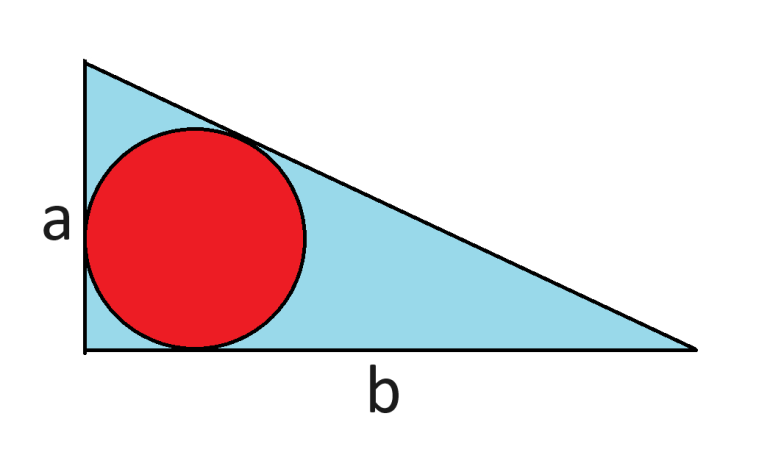
A circle is inscribed in a right triangle with legs of length a and b. What is the radius of the circle? For credit, show your work.
Quote: ThatDonGuy
P{y = 4} = p (1 - p)^4
P{y = 1} = p (1 - p) = 9 p (1 - p)^4
1/9 = (1 - p)^3
1 - p = (1/9)^(1/3)
P{y is odd} = p (1 - p) (1 + (1 - p)^2 + (1 - p)^4 + (1 - p)^6 + ...)
= p (1 - p) (1 + (1 - p)^2 + ((1 - p)^2)^2 + ((1 - p)^2)^3 + ...)
= p (1 - p) / (1 - (1 - p)^2)
= p (1 - p) / (p (2 - p))
= (1 - p) / (2 - p)
= (1/9)^(1/3) / (1 + (1/9)^(1/3))
= 1 / (1 + 9^(1/3))
Is there a way to get the radical out of the denominator?
link to original post
To remove the cube root from the denominator, multiply top and bottom by 1 - x^(1/3) + x^(2/3).
r=radius of circle.
a-r = top portion of left side
drop perpendicular radii to the left side and hypotenuse. The similar triangles in upper left gives
a-r = left portion of the hypotenuse
similarly
b-r = right side of bottom
b-r = right portion of hypotenuse
So sqrt (a^2 + b^2) = hypotenuse = (a-r) + (b-r) = a+b - 2r
r = 0.5*(a+b - sqrt(a^2+b^2))
Quote: Wizard
A circle is inscribed in a right triangle with legs of length a and b. What is the radius of the circle? For credit, show your work.
link to original post
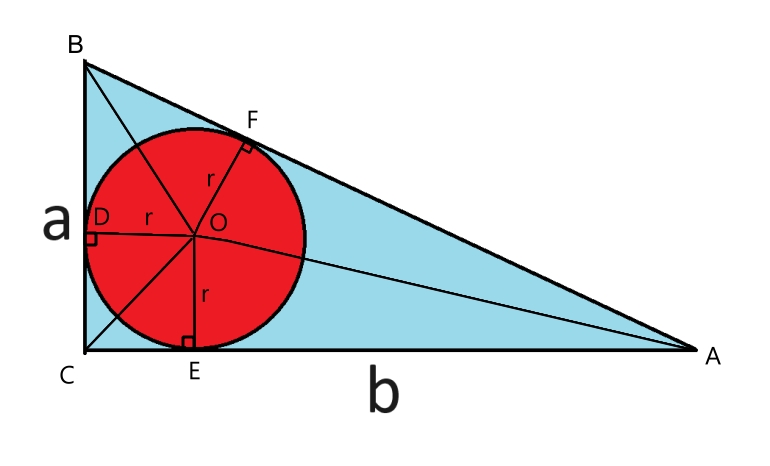
OE = OF and OA = OA, so AOE and AOF are HL-congruent, which means AE = AF
OD = OF and OB = OB, so BOD and BOF are HL-congruent, which means BE = BF
OD || CE and OE || CD, so ODCE is a rectangle; since OD = OE, ODCE is a square, which means CD = CE = r, so BF = BD = a - 4 and AF = AE = b - r
Pythagorean Theorem: (a - r + b - r)^2 = a^2 + b^2
a^2 + b^2 + 4 r^2 + 2 ab - 4 ar - 4 br = a^2 + b^2
4 r^2 + 2 ab - 4 ar - 4 br = 0
r^2 - r (a + b) + ab / 2 = 0
r = (a + b) / 2 +/- sqrt(a^2 + 2ab + b^2 - 2ab) / 2
= (a + b +/- sqrt(a^2 + b^2)) / 2
However, r < a/2 as otherwise the diameter of the circle would be longer than one of the sides
Therefore, r = (a + b - sqrt(a^2 + b^2)) / 2
Note that this is always positive because of the triangle inequality, as a and b are the lengths of two sides of the triangle and sqrt(a^2 + b^2) is the length of the third side
Quote: chevy
r=radius of circle.
a-r = top portion of left side
drop perpendicular radii to the left side and hypotenuse. The similar triangles in upper left gives
a-r = left portion of the hypotenuse
similarly
b-r = right side of bottom
b-r = right portion of hypotenuse
So sqrt (a^2 + b^2) = hypotenuse = (a-r) + (b-r) = a+b - 2r
r = 0.5*(a+b - sqrt(a^2+b^2))
link to original post
I agree!
Same credit to ThatDonGuy.
Quote: WizardI agree!
Same credit to ThatDonGuy.
link to original post
And now, for bonus points:
Suppose it isn't a right triangle, and the third side has length c.
In terms of a, b, and c, what is the radius of the inscribed circle (i.e. the circle internal to the triangle that is tangent to all three sides)?
Showoff.Quote: ThatDonGuy
OE = OF and OA = OA, so AOE and AOF are HL-congruent, which means AE = AF
OD = OF and OB = OB, so BOD and BOF are HL-congruent, which means BE = BF
OD || CE and OE || CD, so ODCE is a rectangle; since OD = OE, ODCE is a square, which means CD = CE = r, so BF = BD = a - 4 and AF = AE = b - r
Pythagorean Theorem: (a - r + b - r)^2 = a^2 + b^2
a^2 + b^2 + 4 r^2 + 2 ab - 4 ar - 4 br = a^2 + b^2
4 r^2 + 2 ab - 4 ar - 4 br = 0
r^2 - r (a + b) + ab / 2 = 0
r = (a + b) / 2 +/- sqrt(a^2 + 2ab + b^2 - 2ab) / 2
= (a + b +/- sqrt(a^2 + b^2)) / 2
However, r < a/2 as otherwise the diameter of the circle would be longer than one of the sides
Therefore, r = (a + b - sqrt(a^2 + b^2)) / 2
Note that this is always positive because of the triangle inequality, as a and b are the lengths of two sides of the triangle and sqrt(a^2 + b^2) is the length of the third side
link to original post
Quote: ThatDonGuySuppose it isn't a right triangle, and the third side has length c.
In terms of a, b, and c, what is the radius of the inscribed circle (i.e. the circle internal to the triangle that is tangent to all three sides)?
link to original post
I admit I had to use Heron's formula for this one. As a reminder, it says the area of the triangle is sqrt(S*(S-A)*(S-B)*(S-C)), where S=(A+B+C)/2.
Let's call that area x.
Let's call the radius of the inscribed circle r.
x = Ar/2 + Br/2 + Cr/2
r = 2x/(A+B+C)
When asked "Are you mad?" she will answer "no" 100% of the time when not mad and "no" 80% of the time when mad.
You ask her if she is mad and she says "no." What is the probability she is mad?

Image source: https://www.focusonthefamily.com/marriage/dont-let-your-spouse-make-you-angry/
(a) Is "not mad" (90%), says "not mad" (all the time) = 90%
(b) is "mad" (10%), says "not mad" (80% of these) = 8%
(c) is "mad" (10%), says "mad" (20% of these) = 2%.
So there are 90 + 8 occcasions when she says she is not mad. 90 of the time she is correct, 8 she is mad.
So the chances of being mad = 8/98 (and being fine is 90/98).
In normal similar cases you're using a test to see whether a patient has a disease. You know the test will give both false positives and false negatives. So the problem for a doctor is how much useful informaton does the test give. Typically the chances of having the problem is low so, unless the test is very good, the result isn't that useful because the chances of getting a false positive is similar to that of a true positive.
Quote: charliepatrickIn this case there are no false results when not mad, so we can consider the chances of three things.
(a) Is "not mad" (90%), says "not mad" (all the time) = 90%
(b) is "mad" (10%), says "not mad" (80% of these) = 8%
(c) is "mad" (10%), says "mad" (20% of these) = 2%.
So there are 90 + 8 occcasions when she says she is not mad. 90 of the time she is correct, 8 she is mad.
So the chances of being mad = 8/98 (and being fine is 90/98).
In normal similar cases you're using a test to see whether a patient has a disease. You know the test will give both false positives and false negatives. So the problem for a doctor is how much useful informaton does the test give. Typically the chances of having the problem is low so, unless the test is very good, the result isn't that useful because the chances of getting a false positive is similar to that of a true positive.
link to original post
I agree!
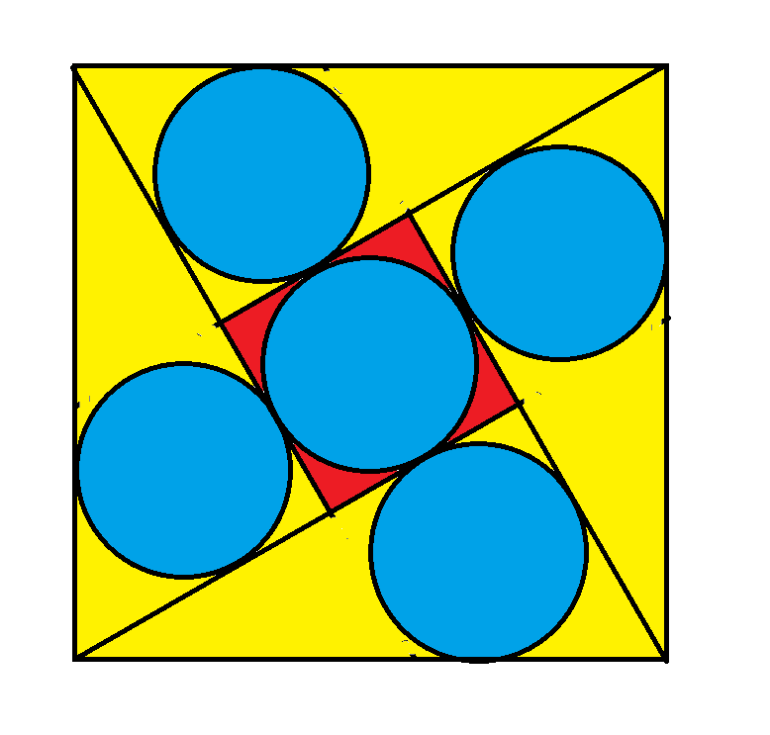
The square has sides of length 1. All the triangles are the same size. All the circles have the same size. What is the radius of each circle?
Quote: WizardThe following is a follow-up on my circle in a right triangle puzzle a few days ago.
The square has sides of length 1. All the triangles are the same size. All the circles have the same size. What is the radius of each circle?
link to original post
r=(sqrt(3)-1)/4 ??(changed it 4 times, so probably still wrong)??
a = short side of triangle
b = long leg of triangle
1 = hypotenuse of triangle = side of big square
a^2 + b^2 = 1^2
From last problem
r = (a+b-sqrt(a^2+b^2)) /2 = (a+b-1)/2
2r+1 = a+b
4r^2+4r+1 = a^2+2ab+b^2 = 2ab+1
so
2ab = 4r^2+4r
From total area= 4*Area triangle + area of square
1^2 = 4 * (.5ab) + (2r)^2
1 = 2ab+4r^2
1=(4r^2+4r) +4r^2
8r^2+4r-1=0
r = (-4 +/- sqrt (4^2 - 4(8)(-1)))/(2*8)
positive root
r=(-4+sqrt(48))/16
r=(-1+sqrt(3))/4
maybe????
Quote: chevy
r=(-1+sqrt(3))/4
maybe????
link to original post
I agree!!!
Quote: WizardQuote: ThatDonGuySuppose it isn't a right triangle, and the third side has length c.
In terms of a, b, and c, what is the radius of the inscribed circle (i.e. the circle internal to the triangle that is tangent to all three sides)?
link to original post
I admit I had to use Heron's formula for this one. As a reminder, it says the area of the triangle is sqrt(S*(S-A)*(S-B)*(S-C)), where S=(A+B+C)/2.
Let's call that area x.
Let's call the radius of the inscribed circle r.
x = Ar/2 + Br/2 + Cr/2
r = 2x/(A+B+C)
link to original post
That is correct. I actually got the answer expressed differently:
r = (b + c + a) / 2 * sqrt(a^2 - (b - c)^2) / sqrt((b + c)^2 - a^2)
Proof that the two answers are the same:
((b + c - a) / 2 * sqrt((a^2 - (b - c)^2) / ((b + c)^2 - a^2)))^2
= (b + c - a)^2 * (a^2 - (b - c)^2) / (4 ((b + c)^2 - a^2))
= (b + c - a)^2 * (a^2 - (b - c)^2) / (4 (b + c + a)(b + c - a)
= (b + c - a) * (a^2 - (b - c)^2) / (4 (a + b + c))
= (b + c - a) * (a - (b - c)) * (a + (b - c)) / (4 (a + b + c))
= (b + c - a) * (a + c - b) * (a + b - c) / (4 (a + b + c))
= (a + b + c - 2a) * (a + b + c - 2b) * (a + b + c - 2c) / (4 (a + b + c))
= (2S - 2a) (2S - 2b) (2S - 2c) / (8S), where S = (a + b + c) / 2
= (S - a) (S - b) (S - c) / S
= S (S - a) (S - b) (S - c) / S^2
= (sqrt(S (S - a)(S - b)(S - c)) / S)^2
= (Area / ((A + B + C) / 2))^2
= (2 * Area / (A + B + C))^2
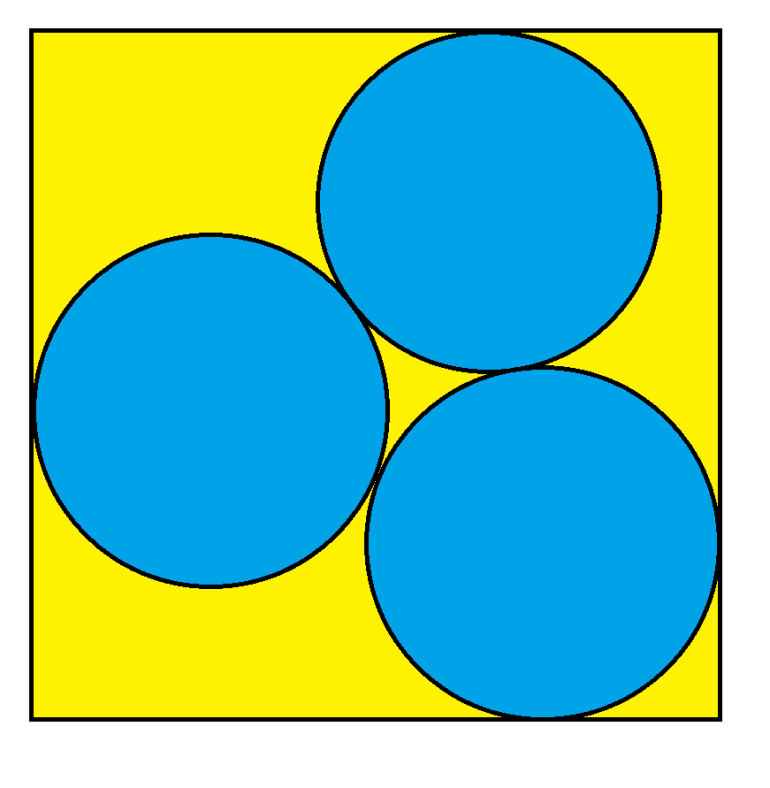
What is the side length of the minimum size square that can fit three circles of radius 1? I am not saying they have to be arranged as in the picture above, but I can't immediately think of a better way.
Hint: cos(x+y)=cos(x)*cos(y)-sin(x)*sin(y)
Quote: Wizard
What is the side length of the minimum size square that can fit three circles of radius 1? I am not saying they have to be arranged as in the picture above, but I can't immediately think of a better way.
Hint: cos(x+y)=cos(x)*cos(y)-sin(x)*sin(y)
link to original post
I think it does have to be with the three circles symmetric about the diagonal.
Start with two circles stacked on top (e.g. 2&3 in my pic) - need square of height 4r=4*1=4
then rotate the three circle arrangement counterclockwise, the height gets smaller
Eventually when you cross the diagonal the width starts to get wider until the case where two circles are side by side (1&3 in my pic).....so square is 4r = 4 wide.
That is process is symmetric, so the midpoint is the min.....(unless it hits a min, increases to the diagonal, then back to a min, before increasing to the max).....Handwaving says it isn't.
Then
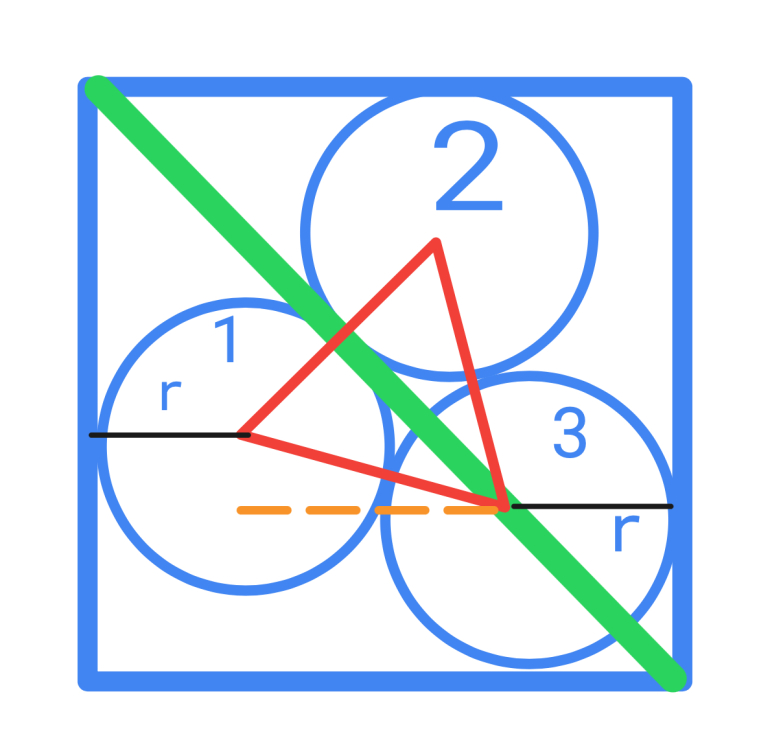
Green diagonal at 45 degrees above horizontal
red equilateral triangle connecting centers has side 2r = 2 and lower side is at 30 degrees below green. Or 15 degrees above orange dashed line
Orange dashed line is (red side) * cos(15) = 2 cos(15)
half angle formula....
cos(15)= sqrt((1+cos(30))/2) = sqrt ( (1+ sqrt(3)/2)/2) = sqrt((2+sqrt(3))/4) = sqrt(2+sqrt(3)) / 2
So orange dashed = sqrt(2+sqrt(3))
and width of square is
black + orange dashed + black
1+sqrt(2+sqrt(3))+1
2+sqrt(2+sqrt(3)) or about 3.93185165258
PS: I am embarrassed just how sloppy this is, but a it is an attempt
Quote: chevy
I think it does have to be with the three circles symmetric about the diagonal.
Start with two circles stacked on top (e.g. 2&3 in my pic) - need square of height 4r=4*1=4
then rotate the three circle arrangement counterclockwise, the height gets smaller
Eventually when you cross the diagonal the width starts to get wider until the case where two circles are side by side (1&3 in my pic).....so square is 4r = 4 wide.
That is process is symmetric, so the midpoint is the min.....(unless it hits a min, increases to the diagonal, then back to a min, before increasing to the max).....Handwaving says it isn't.
Then
Green diagonal at 45 degrees above horizontal
red equilateral triangle connecting centers has side 2r = 2 and lower side is at 30 degrees below green. Or 15 degrees above orange dashed line
Orange dashed line is (red side) * cos(15) = 2 cos(15)
half angle formula....
cos(15)= sqrt((1+cos(30))/2) = sqrt ( (1+ sqrt(3)/2)/2) = sqrt((2+sqrt(3))/4) = sqrt(2+sqrt(3)) / 2
So orange dashed = sqrt(2+sqrt(3))
and width of square is
black + orange dashed + black
1+sqrt(2+sqrt(3))+1
2+sqrt(2+sqrt(3)) or about 3.93185165258
PS: I am embarrassed just how sloppy this is, but a it is an attempt
link to original post
We are close, but I don't quite agree. I could be the one in error.
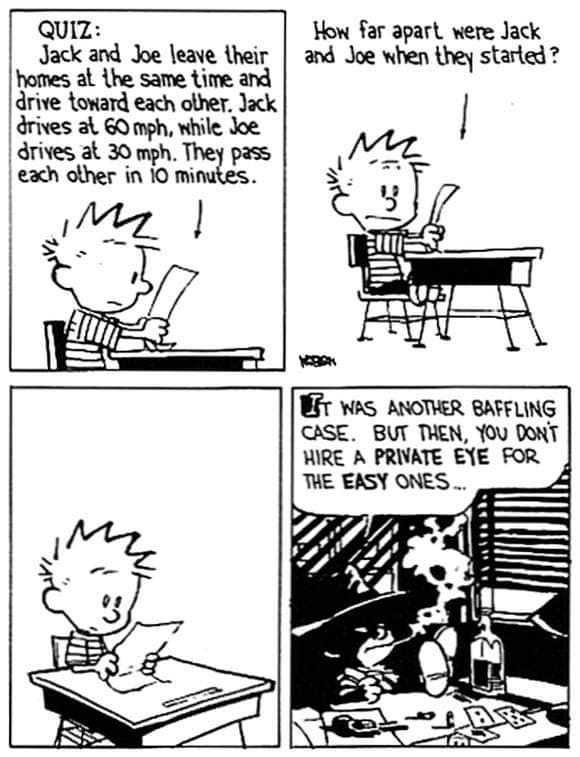
Quote: Wizard
We are close, but I don't quite agree. I could be the one in error.
link to original post
I looked over mine and while certainly can expect I am wrong, I at least right now am not seeing my mistake. If nobody else chimes in, feel free to share yours in spoilers and maybe I can see where I went astray.
Quote: Wizard...We are close, but I don't quite agree. I could be the one in error.
There is a method of calculating cos(15) via cos(30/2), SQRT((1+cos(30)/2) which gives SQRT((2+SQRT(3))/2.
Thus the answer required is 2+SQRT((2+SQRT(3)). A calculator gives this as 3.93185... .


